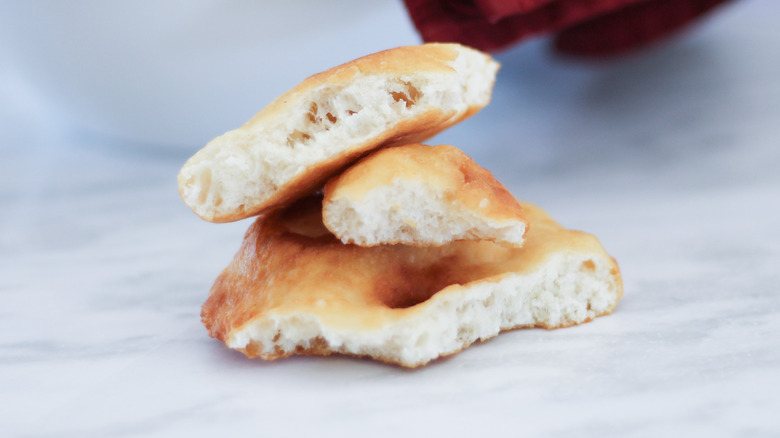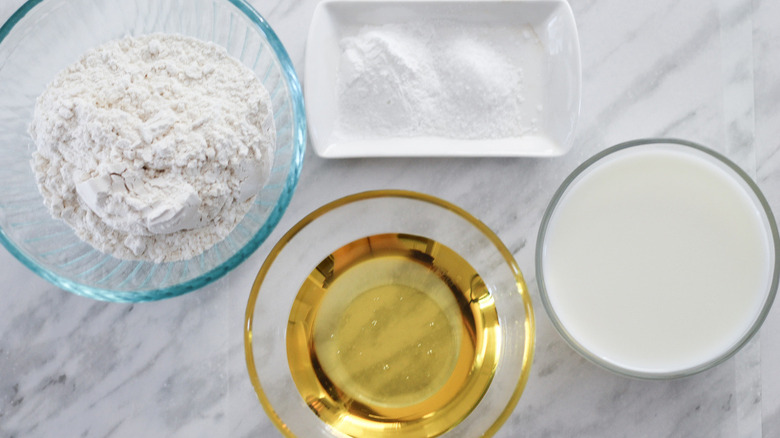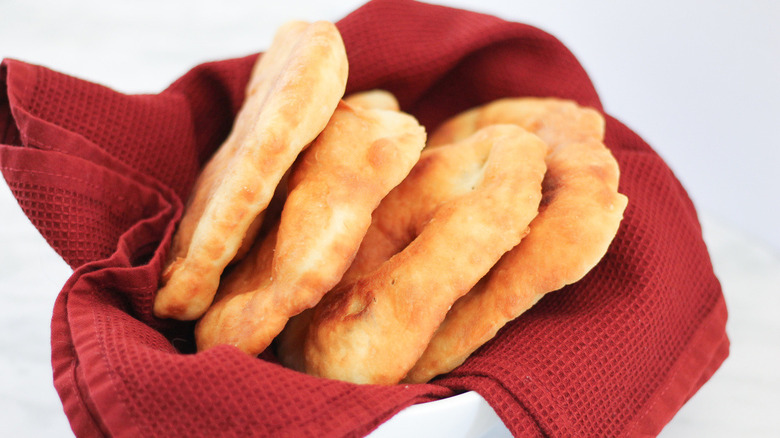Traditional Fry Bread Recipe
If you are a student of culinary history, you may know that fry bread has a rather controversial background. We may think of this type of bread as a traditional Native American dish, but sadly the "tradition" in this case involves tribes being forcibly relocated to areas where they could not grow crops such as corn or beans. Instead, they had to rely heavily on government-issued supplies like flour, sugar, and lard. In a way, fry bread is kind of like an indigenous American equivalent of budae-jjigae, the equally traditional(ish) Korean dish created out of army commissary supplies such as baked beans and Spam.
Still, despite its sad backstory, this Southwestern specialty is not only tasty but also versatile and very cheap to make. Recipe developer Melissa Olivieri tells us: "This fry bread recipe is a quick and easy way to enjoy a traditional fare, and it uses basic pantry ingredients." She goes on to say that the bread is "delicious on its own or topped with a smear of jam or drizzle of honey." However, it can also be used as the basis for savory dishes like ground beef and bean-topped Navajo tacos.
Assemble the necessary ingredients for fry bread
This fry bread, unlike many other recipes, omits any sugar (government-issued or otherwise), which makes it suitable for savory as well as sweet dishes. All you'll need to follow this recipe is flour, baking powder, salt, and milk, plus enough oil in which to fry the bread. Olivieri uses 2% milk but anything will do.
Make the bread dough
Mix all of the dry ingredients together: flour, baking powder, and salt. Stir in the milk until the mixture more or less resembles a ball of wet dough. At this point, dump out the dough onto a flat surface lightly sprinkled with additional flour. Knead it until it becomes less sticky and can be formed into a not-so-wet dough ball.
Shape the fry bread
Cut the dough ball into four equal pieces, then flatten each piece and roll it out into a rough circle or oval about ½ inch thick. Once you've rolled out all four dough discs, take your finger and poke them in the middle to make a hole. This hole, Olivieri explains, "helps to prevent the dough from puffing up too much in the center and not cooking through while frying."
Fry the bread
Heat the oil to 350 F — be sure to use a thermometer to check, as too high a temperature can pose a fire hazard, while too low a temperature will result in soggy bread. Olivieri adds, "I prefer a Dutch oven for frying as it is nice and deep and keeps the oil from spraying." Fry the pieces of dough one at a time for about 90 seconds on each side.
Once the bread is done, it should be puffy and light gold in color. Olivieri has one more tip for frying and shares, "I like to swirl the dough in the oil [...] to ensure that it is coated in hot oil for cooking." (She uses metal tongs to hold the dough while doing so.)
Serve the fry bed piping hot
Once the bread is cooked, let it drain for a few minutes on a plate lined with paper towels. This will help to absorb any excess grease. While fry bread is best eaten warm from the hot oil, you can always reheat the uneaten pieces in the microwave or oven.

- 1 cup all-purpose flour (+ extra for rolling surface)
- 1 ½ teaspoon baking powder
- ½ teaspoon kosher salt
- ½ cup milk
- 2 cups vegetable oil
- Combine the flour with the baking powder and salt.
- Stir in the milk, mixing until it forms a ball of wet dough.
- Turn the dough out onto a lightly floured surface and knead until it is less sticky and forms a ball.
- Cut the dough into 4 equal pieces.
- Press down on each dough piece, then roll it into a disc about ½ inch thick.
- Poke the dough in the middle to create a hole.
- Heat the oil in a large pot to 350 F.
- Fry one piece of bread at a time for about 90 seconds per side or until puffy and light golden in color.
- Drain the fry bread on a paper towel-lined plate to absorb the excess grease.
- Fry bread should be eaten warm, but it can be reheated in the oven or microwave.
| Calories per Serving | 218 |
| Total Fat | 10.9 g |
| Saturated Fat | 1.2 g |
| Trans Fat | 0.1 g |
| Cholesterol | 3.1 mg |
| Total Carbohydrates | 25.7 g |
| Dietary Fiber | 0.8 g |
| Total Sugars | 1.6 g |
| Sodium | 170.0 mg |
| Protein | 4.2 g |






